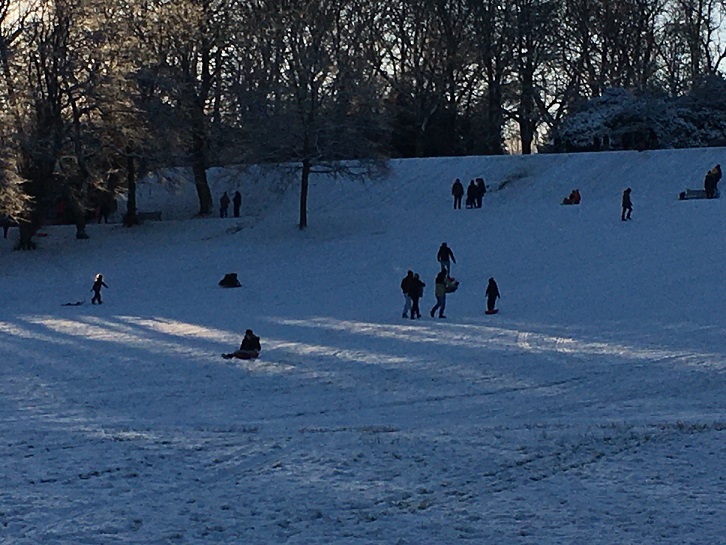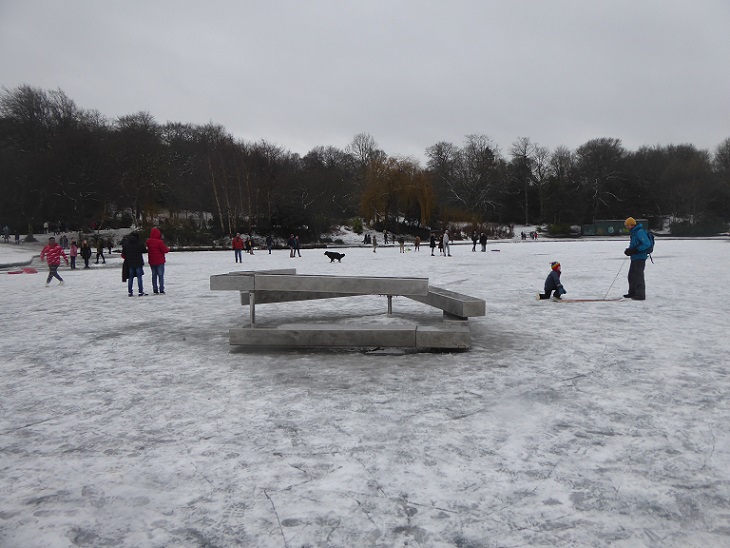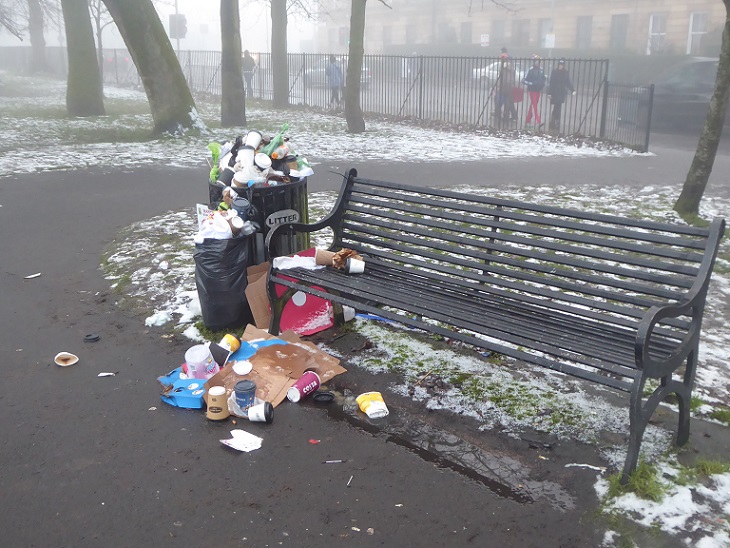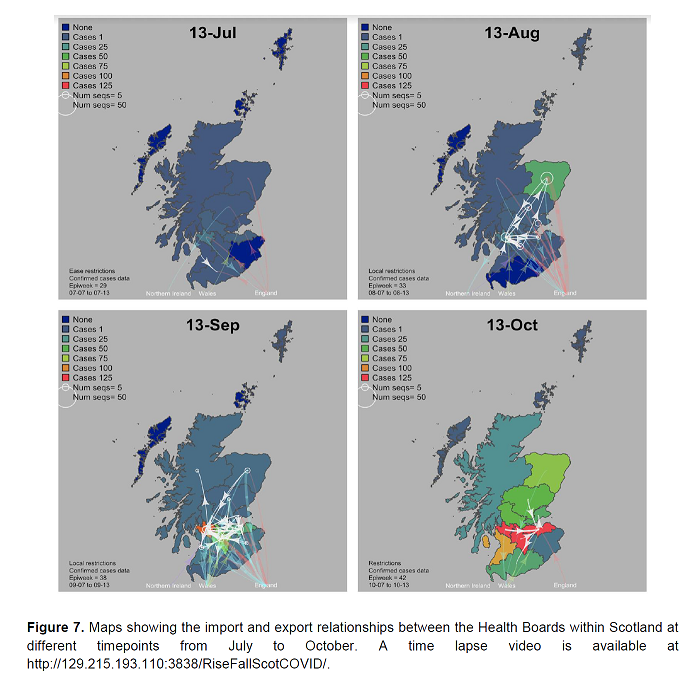
[Update. While I checked the law at New Year, I did not realise when drafting the post the list of reasonable excuses for leaving the place you are living was amended on 5th January (see here clause 18 (2) t) to include outdoor recreation. I have consequently amended the post which had highlighted the differences in the law between going out for exercise and outdoor recreation. I am grateful to Mountains of Scotland for bringing this to my attention and apologise for the error].
There is no doubt that we have been and continue to be in a dire situation when it comes to the Covid pandemic and its consequences. But, in the gloom, outdoor recreation provides some salvation. It’s about the one thing people can do safely, with a little common sense, when the world about them is collapsing.

The cold snap arguably came at just the right time, just as further restrictions were being imposed. It can be difficult for people to motivate themselves to get outdoors on dark days, but the freeze showed the world is still a wonderful place. There were thousands of people out enjoying the snow and the ice in the parks and the countryside round Glasgow, albeit with hopelessly adequate infrastructure. We should be celebrating and learning from that.

The doomsters and authoritarians, however, will disagree. They argue that because there is a more transmittable new variant of the virus (which I don’t dispute) nowhere is safe, even outdoors. They focus on the “rule” breakers, argue that people cannot be trusted to stay apart and that as a consequence we need more laws to force people to stay at home. They may point to the casualties of the freeze and argue going out and risking a broken bone is irresponsible when parts of the NHS are under such pressure.
With rising levels of infections and deaths, I was fearful that the Scottish Government would listen to the voices urging further restrictions on the ability of people to go out for outdoor recreation. In fact, to their credit, the Scottish Government have stood by the science which still says the risk of the virus transmitting outdoors is very low (except for specific situations, like when people are part of a crowd) and that the adverse consequences to people’s physical and mental health to confining them at home is very high. What is more, on 5th January they amended the law so that outdoor recreation as well as exercise is included on the list of reasonable excuses for leaving your home, correcting an anomaly that has existed since the lockdown started last March.
Meantime, the UK Government ,which up until now in many ways appeared to be more sympathetic to the benefits of outdoor recreation, but had been very slow to impose other lockdown measures in December, panicked and introduced similar restrictions as to last March:
“You should minimise time spent outside your home, but you can leave your home to exercise. This should be limited to once per day, and you should not travel outside your local area.”
The stupidity of these rules have been graphically illustrated by two incidents, the Police being forced to apologise to two women who had met up to go for a walk away from the crowds in Derbyshire (see here) and Boris Johnson, who was caught cycling 7 miles from Downing St along with his security entourage. As a doctor speaking on Radio 4 commented, the people who make the “rules” should keep to them but Boris needed the exercise! A nice way of saying the “rules” are not fit for purpose.
One would hope now that the Scottish Government learns from those UK Government mistakes.
Travel and outdoor recreation
A large part of the problems is that both our governments have been including outdoor recreation in restrictions designed to reduce travel.
The normal meaning of travel is to “go from one place to another, often to a place that is far away” (Collins (see here)). While the word is used to refer to day trips – s/he travelled to London and back in the day or s/he travelled by car (and I will use it in that sense below) – it sounds strange to say “I travelled out to the countryside for a walk”. Unfortunately, in response to the surge in Covid-19, government and individuals have been doing just that and treating day trips to the countryside in the same category as international travel or travelling around the UK.
Unfortunately, while trying to restrict what doesn’t matter – people going out to the countryside for a walk – government have been failing to control what properly counts as travel. People travelling into or returning to the UK or Scotland will only require to prove they have had a negative test from this Friday, weeks after other European countries introduced such requirements. We still have no enforced quarantine on people who travel long distances, as happens in other countries.
In early December, the Scottish Government announced that Covid-19 had been almost eliminated before “travel” re- introduced Covid-19 (see here). This was based on some very interesting research that had been considered by SAGE (the Scientific Advisory Group for Emergencies) about the different strains of Covid-19 circulating in Scotland and Wales (see here). This showed that the strains of Covid-19 circulating at the start of the pandemic had almost entirely disappeared by the summer but new ones had been introduced:
“the majority of lineages responsible for the second wave are new introductions from outside of Scotland and many from outside of the UK. This indicates that, while lockdown in Scotland is directly linked with the first wave case numbers being brought under control, travel-associated imports (mostly from Europe or other parts of the UK) following the easing of lockdown are responsible for seeding the current epidemic population”.

The report provided detailed evidence for this, for example:
“Reflecting different travel patterns, there was a higher proportion of B.1.5 in Scotland than the rest of the UK (6% of Scotland sequences, <2% rest of UK); and global lineage B.1.93 was almost exclusive to Scotland (representing 14% of Scotland sequences, but only 12 sequences from the rest of the UK). Lineages with a greater total number of sequences in Scotland than the rest of UK, and for which there are significantly more sequences sampled (Fisher test, P<0.0001, and Bonferroni correction) are: A.2, A.3, A.5, B.1.1.12, B.1.1.14, B.1.1.20, B.1.1.28, B.1.100, B.1.101, B.1.40, B.1.5.10, B.1.69, B.1.70, B.1.71, B.1.77, B.1.89, B.1.9, B.1.90, B.1.93, B.16, presumably reflecting different travel destinations.”
Not only did the virus enter into Scotland from abroad, it was also transmitted from Scotland to other countries by international travel and to other parts of the UK:
“Using this approximate measure, we estimate 307 imports and 158 exports to and from Scotland respectively over the whole date range (Supplementary figure 2), close to our previous analysis (Filipe et al. 2020) where we estimated >280 introductions based on sequences sampled to the end March and known travel histories”.
Scotland wasn’t just on the receiving end, we were also responsible for dishing out the virus elsewhere.
The report also plots how the new strains of Covid-19 spread between Health Boards areas in Scotland:
“Importantly, while some of the wave 2 lineages are re-introductions from other parts of the UK, the majority are introductions from outside of the UK which seed new lineages (Figure 6). Once introduced these lineages have grown within Scotland spreading to different regions (Figure 7).”

Note that the transmission of the virus WITHIN Scotland is not all one way and, as you might expect from its dense population and economic role, the greatest number of transmission lines either way have been through the Greater Glasgow and Clyde Health Board area.
The report concludes:
“This demonstrates that the impact of stringent public health measures can be compromised if following this, movements from regions of high to low prevalence are not minimised” [my emphasis].
The Scottish Government appears to have read this as meaning they need to restrict movements of people going out for the day for Outdoor Recreation, when the risks are tiny. Covid has spread like wildlfire over the last few weeks, despite the travel restrictions placing severe constraints of Outdoor Recreation. Yes, there are a few people who have gone 5 miles beyond their local authority boundary for outdoor recreation, but that cannot explain the spread of the virus in the last two months. Factors like students returning home and supply chains, which involve real travel, are far more likely to explain what has gone wrong. Lorries travelling from Europe are still exempt from testing, they drive across the Scottish Border, still without checks, and from there further supply chains transmits the virus to remote parts of the Highlands. Like outdoor recreation, however, it’s not the travel or moving in itself that spreads the virus (unless it by communal transport like train or aeroplane), its the contacts people have at their destination, particularly indoors, that matters. Hence the importance of strict quarantine if people do move place.
If outdoor recreation was responsible for spreading Covid-19, one might have expected the new variants of Covid-19 brought into Scotland at the end of the summer to have rapidly spread throughout the Highlands and places like the Western Isles that were thronged were tourists. The genomic research doesn’t appear to include any evidence that that happened. A reasonable explanation for this is tourism in rural Scotland, unlike tourism to our cities, is fundamentally outdoor rather than indoor based. What is more tourists visiting the Scottish countryside don’t tend to end each day in the disco or a thronged bar, as happens with much beach or ski tourism. Coupled with the generally very strict adherence to distancing rules indoors by rural businesses, this helps explain why staycations appear to have played very little role in the spread of the virus.
The Scottish Government should learn from that, although it clearly needs to get the virus back under control again before rural tourism can be re-opened.
The current restrictions in Scotland
The law had remained unchanged since the Scottish Government first introduced restrictions on travel out of tier 3 and 4 local authority areas in November (see here) but on 5th January, while imposing new restrictions on many activities, the Scottish Government added outdoor recreation to exercise on the list of reasonable excuses for being outdoors. This means that if you travel within your local authority area or five miles beyond it for either exercise or outdoor recreation you have a legally recognised reasonable excuse for doing so. This corrects the anomaly that up until now if you lived in Glasgow or Edinburgh you could be certain that you could legally drive to the parts of the Kilpatricks or Pentlands that lie within five miles of the city boundaries for exercise, it was less clear whether you might be issued with a Fixed Penalty Notice by the police if you make that same journey to fish, birdwatch, sledge or undertake other forms of outdoor recreation. That is extremely positive, if long overdue.
The Scottish Government has, however, offered new advice:
“Travel no further than you need to reach to a safe, non-crowded place to exercise in a socially distanced way.”
Taken together while this means there is nothing illegal about travelling from one side of Highland Region to the other for a day’s exercise, it is now strictly frowned on. On the positive side, Scottish Government guidance does now at least appear to recognise that finding uncrowded places locally can be problematic.
It is possible therefore that travelling five miles beyond your local authority boundary for exercise or outdoor recreation could be justified on the grounds that everywhere closer was crowded. That has certainly been the case in the countryside around Glasgow on sunny days recently. It is also possible you might be justified travelling to undertake a form of outdoor recreation that was important to your mental health but for which there was no opportunity in your area (like being by the sea if you live inland). The problem, however, is that there is no certainty about this and any person doing so would need to be prepared to justify their “reasonable excuse” to the police and also potentially to the Courts if challenged. Most people don’t want to be put in this position, even if they know that what they propose to do will involve no contact with others and do no harm. The law itself remains hard to justify.
It is also unfair. Fundamentally, in terms of civil liberties and the ability to do things that don’t harm others, people living in geographically large local authorities, such as Highland or the Borders, continue to have far greater rights when it comes to both outdoor recreation and exercise than those living in geographically constrained local authorities, such as Edinburgh, Glasgow and Aberdeen.
What needs to happen
First, the Scottish Government needs to be brave and resist calls for any further restrictions on people’s ability to go out into the countryside for outdoor recreation from where-ever they are living. It knows the risks of outdoor recreation spreading Covid-19 are very low, and that the adverse physical and mental health impacts of confining people to their homes are very real. It should be treating outdoor recreation as a key means by which it assists people to get through the current crisis.
Second, to the extent to which the more transmittable version of the virus might pose a risk outdoors, it makes no sense to sense to advise people living in settlements to “Stay Local” when it comes to outdoor recreation. There is simply not enough greenspace and its very difficult for people in settlements to stay 2m apart at all times. It would be far better to advise people to disperse people into the countryside, where there are acres of space.
While it would take a very brave government to relax any of the current restrictions until the number of Covid cases is clearly on a downward trend, once the evidence shows that is clearly happening, the Scottish Government should relax the rules (both law and advice) on outdoor recreation. They should do this initially by clearly distinguishing day visits to the countryside from other forms of travel. They could then introduce a proportionate and fair set of rules about going into the countryside for the day for outdoor recreation, that treats all people in Scotland equally. This would benefit everybody. The key issue for government in 2021 would then become how we in Scotland can improve the infrastructure necessary to support outdoor recreation, both in the short-term and the long-term? I will consider that question, in the light of the evidence from the last couple of months, in a couple of further posts.
Excellent piece Nick. I have 2 observations to make, not to criticise. There are no easy answers. Firstly, the travelling, or journeying restrictions. If relaxed for outdoor recreation as suggested, it broadly favours the well off middle classes, who already might well have their own outdoor space, by allowing the use of private transport to access the countryside, an option not open to a large sector of the population, generally poor, in homes without gardens, who have only the option of limited, and potentially dangerous, public transport. It really does emphasise that we are not all in it together. And secondly, bins overflowing with uncompacted disposable items does not mean councils should empty bins more. It means government banning the use of this disgusting stuff, so folk take their drinks and sandwiches out from home in reusable containers. Stay safe. And active wherever.
Thanks Phil, I agree totally on the fairness question. One of the problems parkswatch, which tries to focus on National Parks, is that by doing so it avoids questions of people who cannot get out to National Parks. I keep trying to make the argument for improved public transport but that mitigation is not possible at present and I think there is a really strong argument for the Scottish Government to be investing considerable amounts in improving greenspace around poorer communities. I also agree that the way to address the rubbish issue is to reduce it at source but until government acts on that I think there should be a duty on the public sector to ensure litter bin provision is sufficient. The problem is portrayed as one of individual responsibility when it should be regarded as a government responsibility.
Although it is clearly an aspiration in certain quarters, it is not currently true that private transport is restricted to “the well off middle classes” as a look at any ordinary council housing scheme will demonstrate. This is related to the reluctance to admit that there is no significant risk of infection in travelling by private transport while the opposite is true of public transport. When pressed on this its proponents rapidly end up with “you might have an accident and need the emergency services” – or you might stay at home and fall down the stairs, or try to commit suicide (up 60% in the London area apparently) because of the isolation.
The vehicle based campers whom LLTPA for one is keen to demonise and eliminate are clearly not “well off middle class”.
Also remember that as a number of politicians have admitted, some of the restrictions are there to convince people that the situation is serious, not to restrict transmission per se.
It is particularly annoying to see the clamour, urged on by the media, for more and more specific laws restricting the public and removing the ability to act on the basis of one’s own informed assessment of the actual risk involved.
If you do so, then check the regulations and find that what you need to do is in fact deemed legal, this is framed by the FM etc. as “exploiting a loophole”. There is also clearly a risk that the police will decide you are “not in the spirit of the regulations” and fine you anyway, or go down the “culpable and reckless conduct” route.
All this is accepted on the basis that it encourages people to stay in their homes which is A Good Thing and apparently not contradictory of the advice that fresh air and exercise is beneficial in combating CV19.